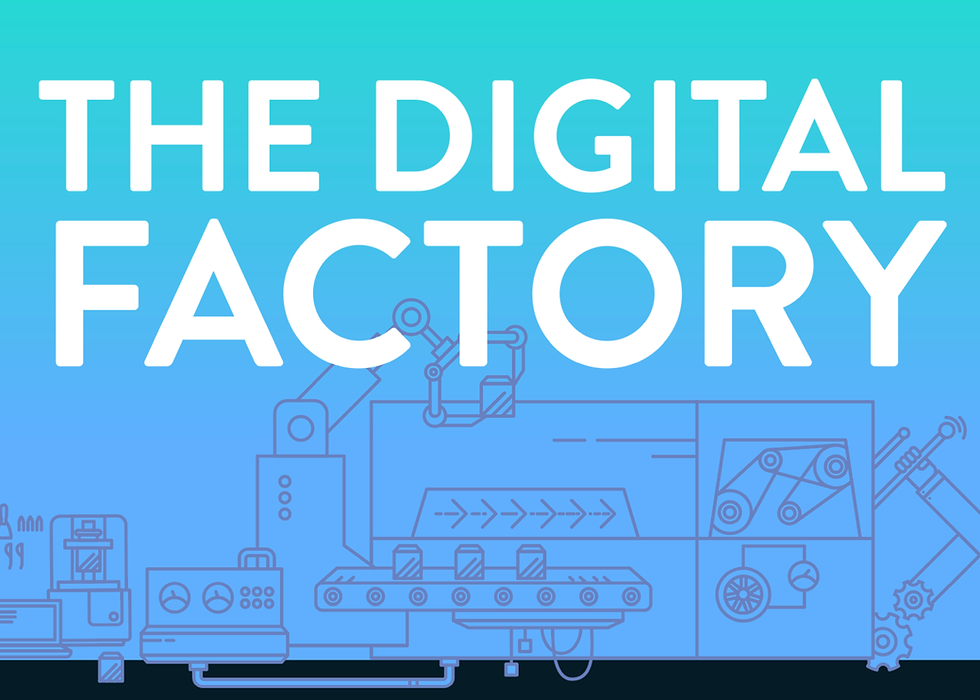
Last week a group of startups, 3D printing industry veterans and established players from the larger manufacturing world gathered in Garching for “The Digital Factory”. The one day conference featured a large number of talks about enterprise 3D printing, both from people within and outside the industry.
There was a single track for the morning sessions that everyone attended. After lunch, the audience split up into three different rooms, each with its own larger topic: strategy, additive manufacturing and automation. In total, one could listen to up to 14 talks in one day, with a choice of three different options for four of them.

Picture 1: The main conference room during one of the morning presentations
Perhaps the topic of most concern to everyone at the event, both presenters and audience members, was digitalization. Many talks centered around this topic, both within 3D printing and outside of it.
Despite how it may seem, there are still many steps in the 3D printing workflow that require manual labor, both during digital pre-processing and post-processing. Gil Perez of SAP presented examples of software solutions developed by SAP that automate the handling of requests, orders and print jobs. Jerry Perkins of Henkel shared his company’s ideas for post-processing, particularly the merging of individually 3D printed parts into larger objects by adhesion.
The conference was hosted by Formlabs. The company showcased a prototype of its Fuse 1 desktop SLS printer as well as its FormCell technology, an automation system for its line of Form 2 printers. The FormCell can monitor and control several Form 2 printers, as well as automatically removing finished jobs from the printers. A shop that is running Form 2 printers at high utilization can use the FormCell to print several jobs through the night or the weekend without the need for an operator to remove the finished jobs and start new ones. Henkel, Shaper and GE also supported the event.

Picture 2: The FormCell system with several Form2 running inside of it
In the larger manufacturing industry, 3D printing enables digital product solutions, mostly in the form of lot 1 or small lot production and mass customization. Deutsche Bahn makes use of 3D printing to ease the provision of spare parts and customized labels for its large machine and building infrastructure, as presented by Stefanie Brickwede. The mobility provider has founded “Mobility goes additive”, an initiative to bring together mobility providers and 3D printing experts to find solutions for this particular application space.
Off the rail and on the road, the car maker BMW has for a long time been a supporter and user of 3D printing. The company has recently launched a suite of 3D printed customization accessoires for its fashionable line of MINI compact cars, as presented by Christian Gröschel who works for BMW’s additive manufacturing department.
Several startups were at the conference, from software developer to hardware maker and contract manufacturers:
Trinckle, the Berlin startup for customizable products and other software based 3D printing solutions
Trovus Tech, one of the few startups in contract manufacturing for metal 3D printing from Roding, an industrial area in northeastern Bavaria
Kumovis, a bavarian hardware startup developing an FDM printer specifically designed for handling Peek filament and targetting the medical device industry
Simscale, a munich based startup that offers Computer-Aided-Engineering in the cloud
Gramm, a consultancy and engineering firm from Regensburg serving enterprise clients
Digital technoloy requires software in order to be used. No 3D printer can be manually controlled to print an object. A piece of software is required to build the 3D model, and another transforms that model into a set of machine instructions that can be carried out by the 3D printer. But it is also only through software that the potential provided by digital technology can be fully leveraged. Advanced pre-processing software may increase the packing density of a 3D printing job to increase the yield of a machine. Brokering services may provide automated matching of part buyers and contract manufacturers.
The previously mentioned Simscale is an example of a software company that does not directly offer 3D printing software. But by making CAE more accessible and affordable, it helps grow the digital manufacturing ecosystem that also included 3D printing. But Simscale not only thinks of its software as a validation tool. It wants people to use it for design.
And design is the key to creating value with 3D printing. Design in this context is about taking a need or problem, and then combining existing technologies and methods in an innovative fashion to craft a satisfying solution.
4D printing is one example of exponentiating the solution space for 3D printed products. The term describes the inclusion of time or reconfiguration of 3D printed parts after 3D printing to provide complex functionality within product designs. Kristin Shea, a professor from ETH Zürich presented some of the research projects and solutions developed by her team. Her talk was a powerful example of the usefulness of 3D printing as a tool in the hands of a product designer.

Picture 3: 4D printing as a method for adding powerful features to 3D printed parts
But as was mentioned by Kristin Shea and later looked at in more detail by Alexander Oster of Autodesk in his talk about generative design, software tools are needed to expose the power of computational design to developers, engineers and designers. These tools need to be created, and companies like Autodesk or Simscale are working on it.
Ultimately, the solutions built on 3D printing technology determine the future of additive manufacturing. “The Digital Factory” offered a glimpse of that future.